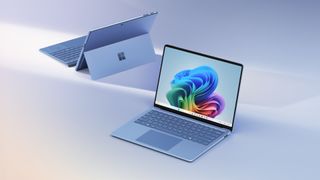May has been a good month for fans of OLED displays. With Apple’s new iPad Pro and Microsoft’s upgraded Surface Pro being unveiled at almost the same time, there’s now plenty of choice when it comes to high-end tablets that boast top-notch screen tech.
Yet a recent comparison from display industry expert Ross Young shows some massive discrepancies between the two devices that you might not have been aware of if you’d just stuck to the two companies’ marketing materials. It follows a previous claim from Young that the iPad Pro would come with several industry firsts, and when you look a little closer, it becomes clear that the iPad Pro’s display is leaps ahead of the Surface Pro’s, on paper.
What’s immediately obvious is the benefit brought by the iPad Pro’s tandem OLED display. The Surface Pro uses a regular OLED panel, which means it tops out at 900 nits of peak brightness and 600 nits of full screen brightness. The iPad Pro, meanwhile, hits 1,600 nits and 1,000 nits in those two categories, respectively. That’s a huge disparity and one undoubtedly facilitated by the iPad’s more advanced tandem OLED technology.
The differences don’t end there. The iPad Pro has a wider refresh rate range (10Hz to 120Hz compared to the Surface Pro’s 60Hz to 120Hz), offers stronger login protection in the form of Face ID versus a fingerprint reader, is significantly thinner and lighter, and offers a chip with a more efficient and advanced 3nm manufacturing process.
Despite all of that, it still comes in cheaper, starting at $1,299 / £1,299 / $2,199 compared to the $1,499 (around £1,180 / AU$2,250) Microsoft charges for the OLED version of the Surface Pro.
Which is better?

Of course, not everything is quantifiable by tech specs, and much comes down to how a device feels to hold and use.
The Surface Pro is a 2-in-1 computer that can be used as either a tablet or a laptop, while the Apple requires you to shell out an extra $299 if you want its keyboard for the iPad Pro. That alone might make Microsoft’s device more attractive to you.
The Surface Pro also pulls ahead in a couple of important ways. For instance, it starts with more storage (512GB versus 256GB), supports Wi-Fi 7 instead of Wi-Fi 6E, offers more CPU cores and potentially more GPU cores (although the latter is uncertain right now), starts with more memory and offers a higher memory limit.
Yet it’s hard to avoid the fact that the iPad Pro is most likely the better choice if the display is your most important consideration. While there’s a lot to like about the Surface Pro, Apple has the display crown for the time being.
You might also like
Services Marketplace – Listings, Bookings & Reviews
